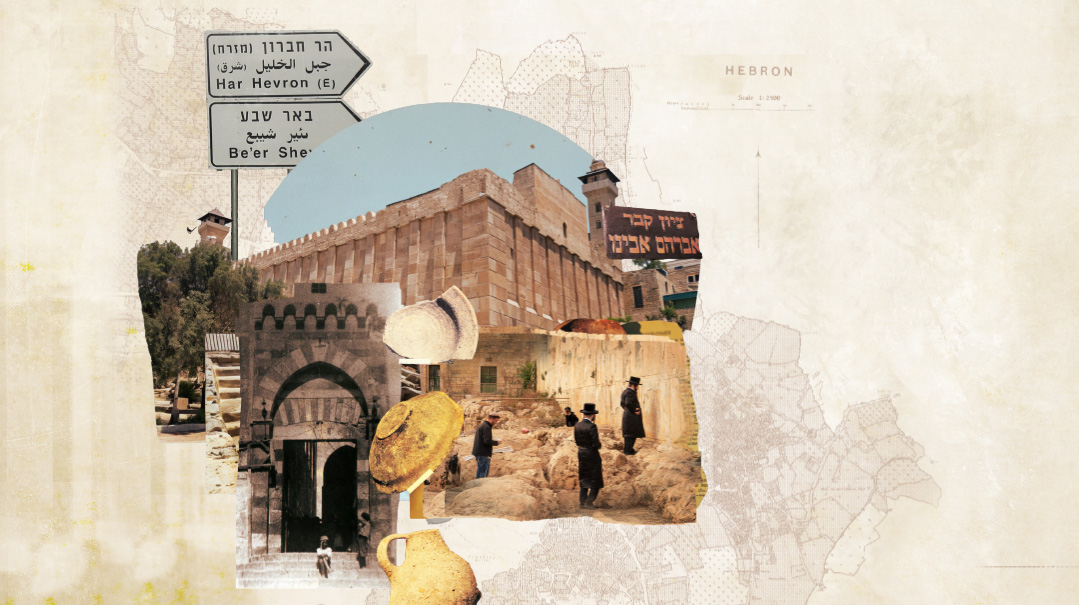The Story of a Home

Sara (Wittler) Vital created a home — Bet Nechama — where struggling teens can discover who they are, without pressure, pretense, or fear

As told to Rivka Streicher
“S
urele, can we talk?” My father took me into his study just days after he’d gotten up from shivah for his father.
“How would you feel about going to live with Grandma for a bit?” His expression said it was a huge request, that he couldn’t really believe he was asking it of a 14-year-old.
“Me?”
“Yes, you’re the oldest grandchild. It’s hard for Grandma to be on her own in the house in Manchester. She won’t move in with any of the children. Not that she has to, she’s only in her sixties and values her independence, you know….”
I knew.
I closed my eyes and thanked my lucky stars.
“I’ll go,” I said.
He — everyone in the family — was so grateful, but they didn’t realize that for me this was a get out of jail free card. I’d always had a hard time conforming to societal rules — and in the small yeshivah town of Gateshead where we lived, there were many. I was the oldest of nine with a lot of responsibility and not much freedom, and with my curly red hair and free spirit, all the expectation on me led to a lot of internal angst and emotional struggle.
And school came with its own challenges.
I moved to Manchester, where I went from a place of struggle and lots of responsibility, to living with my grandmother, Mrs. Nechama Wittler, who unconditionally adored me. She was so grateful that I’d come to live with her and gave me a lot of healthy freedom. She was a tzadeikes and it flowed out of her, but her approach to Yiddishkeit wasn’t imposing or overbearing.
She was known as the “brachos lady” of Manchester. From her window we could see the goings-on of the town. Watching a woman pass by with a double stroller and more children hanging off the sides, she’d say, “There goes so-and-so. Hashem, please give her strength to take care of her kinderlach. May they be blessed….” Hashem was real to her. Right in front of her. Her blessings were a prayer to Him — and a joy to others.
I loved her positivity and caring. We had good times, lots of wit, and an easy camaraderie — except for when we didn’t. There were some challenges to our dynamic, she, a fresh widow, and me, an erratic teen. Both of us passionate people, we’d sometimes get into a tiff about something or other.
I remember calling my father one time and protesting, “I’m not even doing a mitzvah by being here, I’m just getting into a headlock with her.”
“Surele, just the fact that she’s got who to get into a fight with, that’s the mitzvah,” my father said.
It was wry and true. But there was more to it. I felt that because I was living with her, other people looked at me differently: I could only do right in their eyes. I was no longer seen as the too free-spirited student, I was lauded as a tzadeikes by my family and by people in school, as if it were mesirus nefesh for me to be with her.
My day-to-day life with my grandmother was a lot easier than it had been at home. At 14, I already knew that we live in an olam hasheker. People will praise you for certain external things, but the real struggles? Those, no one sees.
I ended up living with my grandmother for two full years, experiencing her love and acceptance, and the positive effect being taken out of your normative environment can have — when it’s necessary.
It was life-changing and life-molding. In a way, I was the very first “Bet Nechama” girl.
Breaking Ground
“Bochur looking for a frum home in Jerusalem. English-speaking.”
In my kitchen in Kiryat Sefer, the ad caught my eye.
Could we do it?
It didn’t make sense. I was a young mom of two by then. I had plenty on my plate.
But I turned back to the ad. I understood what it meant to need another home. And I had what it took. My childhood home — much as I had my struggles with the responsibility of being the oldest daughter — was an open and warm home. My parents are beloved by the community. My father is a rav who advises many people. I had that in my bones.
I also had the perfect setup. My then-husband learned and worked from home, so there would be none of the yichud issues typical in these situations.
I called the number on the ad.
The bochur came to stay with us, getting much-needed support and the haven of home.
And just like that we became that family, the ones who took in teens from chutz l’Aretz in need of a place. What I came to learn is that for a teenager who’s not conforming, it’s so difficult to find a frum home amenable to taking them in.
It was a challenge I felt open to. My family was still young, so I wasn’t so concerned about negative influences. More than that, I have an open heart, and I related to these teens. Back when I’d been a teen myself feeling misunderstood by the adult world around me, I vowed that when I became an adult, I wouldn’t forget what it’s like to be a confused, erratic, searching teenager.
For a number of years, we had two or three teens staying with us at any given time. Some stayed very short term, others stayed longer. These teens had to leave their homes for a number of reasons, often because they had difficulty with the system, and needed a lot of encouragement and attention.
Opening our home was a learning curve.
While we offered safety, meals, structure, often these teens were looking for much more. They were here for bed and board, but they were also looking for parents and a family. I remember one girl who was especially resentful about the attention I was giving to my own children, young ones who needed it.
She’d come home in the evening and look at me with puppy eyes that said, I need to talk.
In the middle of putting my kids to bed, I’d say, “Can you wait a few minutes?”
Soon I was receiving notes from her saying things like I know that you don’t really care about me, her bitterness breathing in the words on the page.
I realized that my own growing family was — had to be — my priority. And I learned that I had to be absolutely honest, with her and the others. To confront the elephant in the room and in our relationship. It didn’t do anyone any favors to tiptoe around it.
“The truth is,” I said to her, “that you have the parents Hashem gave you. And I know that there are struggles that come with that. B’ezrat Hashem, you’ll heal, you’ll come to live with that reality. But what’s not realistic is to think that at your age you’re going to find a new set of parents. Yes, there’s this child within you that wants a mommy, but you’re not that little child anymore. I can be a friend, a mentor, a big-sister figure, but the more you’ll look for me to be a mommy, a role I can’t fulfill, the more you’re going to be disappointed.”
It was hard to hear, but to clarify that was to clear the way for growth — in themselves and in the relationship we did have.
Eventually, as our own children got older and it got more complicated to have others around, we changed the system from having the teens stay at our home to renting “yechidot” (studio apartments) for them, close by. Our front door was always open to them — we never did have a front door key. They’d join us for meals, for Shabbos, they could come over whenever. This way, while they had a family that they could feel part of, the boundaries were clearer and that took a lot of weight off the unhealthy expectations.
These teens, young adults really (they were generally around 18) needed to learn independence. The framework we now had — a semi-supervised solution for teens who needed a place — became a successful model which I’d later build on. For several years we continued to help teens in this way.
During that time, I’d been suffering on and off from arthritis. Conventional doctors and treatments couldn’t seem to heal my pain. Eventually, I found my way to Shiatsu, a form of Japanese massage therapy.
I finally started to experience relief from my pain, and I was amazed that an intervention which basically just involved touch could reach such deep places inside and help this much. I’d always considered myself psychological and a deep-thinking person. But through Shiatsu things came up that hadn’t in talk therapy. There was something to this and I was enraptured. I realized how much I was connected to the sense of touch, how deeply I resonated with the energy of this work. I set out to learn Shiatsu.
From there I came to craniosacral therapy, a gentle, hands-on form of bodywork focused on somatic-emotional release and improving the function of the central nervous system. I was awed by what I was discovering about the intelligence held within the body, about cellular memory, and how we could release traumas.
I got licensed in Shiatsu and craniosacral therapy, and began to integrate these therapies into an alternative medicine clinic, as well as doula work. Craniosacral therapy is about feeling the gentle rhythm in the system and trying to rebalance it. Say I’d feel a strain in someone’s body toward the left side. The process is hold, listen, follow, wait. By doing that, for however long it takes, eventually the body will pull itself back into optimal function. If I’d try to push something into place, to force a fix, the body would get more stubborn in its dysfunction.
One day it came to me, an experiential understanding, lightning-clear: It’s the same with dysfunction in our youth. If we could just hold space, with no agenda to fix children or force them to change, that in itself will create space for healing to occur, and they’ll find their way from there.
Foundations
Unfortunately, there were certain things going on in our personal life that would lead to our divorce in 2022. I moved out with some of my children to Ramot. I didn’t want to leave the two teenage girls in our care high and dry, so the girls moved with me.
My grandmother, Nechama, passed away in that period. When I found two apartments close to one another in Ramot, I decided to open an official nonprofit and called the girls’ apartment “Bet Nechama” after my grandmother.
So now I lived in Ramot, the girls coming in and out of my place, much like they did back in Kiryat Sefer. I was doing Shabbos with them. I was mentoring them, helping them find the right therapists and suitable jobs. More girls joined them and the apartment became almost like a girls’ dorm with its own vibe and flavor.
But it was a deeply challenging time for me. I was on my own, living what felt like a limbo life, with so much uncertainty. It was tough going. I was dealing with a lot inside, still holding it together for my kids and giving to the girls. Hashem helped me even then to be able to support others in their brokenness — and I think that the girls witnessing me dealing with real life, gave them strength to face their own paths with fortitude.
That Chol Hamoed Succos, I went to visit Kever Rochel. I sat among the murmuring crowds, feeling very lost inside, not even up to davening. Sitting there, I started to think about Mama Rochel. Who she was. What she’d done. I started talking from my soul. “Mama Rochel, you sacrificed everything for the kavod of your sister, please help me to sacrifice for the kavod of Hashem.”
When I left the kever, I had this incredible sense that my tefillah was heard, that things would change.
Around this time, a dear brother of mine became sick. He went to daven at Kever Rochel prior to undergoing his third surgery. At the kever, he met the Sephardic gadol, Rav Shlomo Bussu. They spoke, and the holy Rav advised him not to rush to have this surgery and advised him to meet someone called Nachshon, who was in the alternative health field, instead.
My father, who was deeply involved in my brother’s case, was understandably wary about this. He said to me, “Surele, you’re in the field, you know this work. I’d like you to meet with this Nachshon person and feel out his work, see if it’s something we should consider.”
I made an appointment and came in with my list of questions about Nachshon’s work and approach, practically like a policewoman.
He wasn’t cowed. He remained calm as I fired my questions, answering them carefully. I felt how centered and grounded he was — as a person and in what he was doing.
I backed off and was able to hear and appreciate what he was saying and how he could help my brother.
Afterward, I was curious about Nachshon’s work, and we arranged to meet again, ostensibly to discuss the field we both had an interest in. I learned that he was Brazilian-born and had only discovered his Jewishness ten years ago, whereupon he’d gone on a long journey to find Hashem, ending up in Israel. He had two children from a previous marriage and was now divorced.
We spoke and connected and before we knew it, we started to date seriously.
I was drawn to Nachshon’s authenticity and depth, how he’s every bit a mevakesh emes; that resonated so strongly with me. He also has a love for helping Klal Yisrael, which aligned with my own work with the girls. I appreciated the complexity and realness of his journey. A relationship started to blossom that was so unexpected, I knew that this was the answered tefillah I’d davened at Mama Rochel’s kever.
A few weeks later we were engaged.
How did Nachshon make a commitment to a woman with nine children plus a home for struggling teenage girls?
It’s his emunah peshutah, how he allows Hashem into his life, and goes with the flow of Hashem’s plan. In that place of trust, nothing’s crazy, anything can work. Admittedly though, what is hard for him to get his head around is anyone wanting to reject the beauty of the Torah life he discovered.
As newlyweds, we were on the lookout for a new home. We found and rented the perfect place on a beautiful street in Ramot. A big house, overlooking the mountains, with two yechidot beneath it. A home for us and my children, that could also be a campus, if you will, for Bet Nechama.
Home
“Bet Nechama” translated literally means “home of comfort.” This beautiful home with windows everywhere overlooking the hills and valleys of Jerusalem is certainly a comfortable home. These comforts help in making this a place the girls love, a place they aren’t resisting.
This goes back to an axiom I know well, that I’ve experienced in my own bones. As long as someone is resisting, they’re not in a place where they can work toward healing.
When people say to me, “What do you do here? What’s your magic?” I say to them, “It’s more about what I’m not doing than what I am,” meaning, I don’t impose things on the girls. I don’t insist that they be a certain way; I certainly don’t fight them. I just try to hold a nurturing space to allow them to heal.
How does a flower grow? You give it some sunshine, some air, a bit of water, and you leave it alone.
I’m here to support the girls, but I’m not trying to fix them. That doesn’t mean that we leave someone to the elements and expect them to flourish — but, like with that flower, force won’t make it grow better. In the right space, with a few supportive needs met, the flowers — and the girls — know what to do, and how to grow.
I try to operate with intention but without agenda, the intention being to bring a girl closer to herself and her spiritual core. To have an agenda about the “exact” or “right way” of doing things, that’s ego. People sense when there’s ego — there’s an accompanying pressure and expectation, it becomes personal and it’s not about them anymore.
There are girls who come and right away try to test me. There’s a rule that they can’t smoke in the house, so a girl will do just that, almost like she’s waiting to get thrown out from the get-go. But I know they’re pushing the boundaries to see if it will get to me.
I tell them, “I want what will work for you. If this is a problem for you, let’s see how we can work around it.”
I want to put it on them, so that they have to face up to themselves, and not make their problems about things outside of them. That’s how you learn to take responsibility for yourself and your actions.
And it’s not like I have many boundaries to begin with.
Parents ask me, “You have no madrichot and there’s no curfew. What stops the girls staying out on Yafo Street all night?”
“Nothing,” I say. “But come check the place at night. Generally, by midnight everyone’s home, in their beds. When it’s on them, they want to do what they know is good for them.”
Of course I’m here in case of emergency. I tell the girls, “If you call me at three a.m. to say that you’re drunk and you can’t get home, I’ll come to get you, and give you a hug. But I’m not going to take responsibility for whether or how often that happens to you. It’s your life.”
It’s not that I don’t care. I do. I care enough that I want the girls to be able to care for themselves. That it should have to be real and not that they drop standards as soon as someone’s not looking over their shoulder.
I think the girls feel quite quickly that there’s not much agenda here, that it’s about them.
At the same time, I’m human and I grapple with this, especially when it comes to keeping Shabbos — which I love and am deeply connected to. I’m saddened by how Shabbos has sort of become the “korban,” one of the first things to go when a teen is struggling. But I’m not here to “get” the girls to keep Shabbos. We have a beautiful meal and discussion groups on Shabbos, exploring things like our associations with Shabbos and understanding the internal beliefs we constructed around it. My intention is that they should taste the goodness of this meditative, retreat-like day, and allow it to touch them. To get involved in what they are or are not observing? I try not to go there.
Coming back to the Bet Nechama name, in a deeper regard “Nechama” means comfort in the sense of offering solace and compassion. To me it’s an injunction to see each girl where she’s at — giving her the compassion she needs to be able to heal.
When a girl arrives at our home, we take a week or two to get acquainted. There’s no “program” handed to her like there would be in an institution.
I try to get to know her. “What interests you? What do you like to do? What are you good at?”
“I don’t know,” is a too common response.
Driven by what society and the system has expected them to do for years, they don’t know how to think about themselves in a healthy way. They don’t really know who they are, that what they want matters — and that it can be their compass. Here’s where the work starts — reconnecting to their core.
I commit myself to be genuine and open with them, saying to them, “You never need to be worried that you don’t know where you stand with me. If something’s bothering me, I’ll tell you to your face.” And I ask them to be open with me in return.
The Family
It starts with Nachshon and myself, heads of the home. I feel strongly that if we, as the adults, could be more authentic about our internal struggles and victories — and children could hear us talking about it and normalizing inner struggle as part of us, part of life — that would help so much. Otherwise, what’s the subliminal messaging? That it’s easy to do everything right and we don’t have struggles?
If there’s ever been a time for truth, it’s now. People look at the nonconforming youth today, and decry their external behavior, they’re just out for party and pleasure or to while time away.
But I know that many times it’s their very depth and searching for truth that causes their behavior, their neshamos rejecting the lies and hypocrisy in certain cases within frum society. The double standards they’ve seen, the “images” people feel the need to uphold at such high cost, the way ego comes in.
To know this gives me the ability to look past their behaviors, to try to see the soul who is suffering from the sheker.
We all grapple with how we were first taught to see Hashem and Yiddishkeit and our concepts of reward and punishment. Was it punitive, negative? Also, there can be a lot of murkiness between what’s really Yiddishkeit and what are someone’s parents’ issues. If a parent says, “Don’t touch muktzeh” in the same way that they say, “Don’t touch my beautiful cake,” the associations blur into one another, and religion becomes associated with control and ego, and using manipulative fear in severe cases.
It’s work to separate the emotional distress from Yiddishkeit. But we can do that by finding genuine Yiddishkeit and reconnecting to it from a mature perspective. Nachshon’s passion for Yiddishkeit is something, and the girls see someone who came from the secular world and chose it. Essentially, his journey is the diametric opposite of the girls’ — he came into Yiddishkeit on his own, from a mature, developed place. He doesn’t have the primal associations we struggle with.
That’s our work. And Nachshon from his place helps the girls to see what that could look like: a clean, “owned” Yiddishkeit.
One recent Shabbos, we were speaking about one’s personal exodus from Mitzrayim. We discussed the need to upgrade our Yiddishkeit from the childish version to the reality we see with adult eyes.
We had a young couple at the meal, a girl who’d been in “Bet Nechama” before Nachshon’s time. She said to him, “I’m jealous of you,” half-laughingly, but also with tears in her eyes. “You don’t have old baggage around this. I want to be there, too.”
“You’ll get there in your own way,” Nachshon told her.
And that’s also the theme of the Pesach program that we ran the last two years, open to girls who can’t do Pesach at home. We had 15 girls join us this year, mostly from strongly religious homes, who are struggling, and some from more modern homes on journeys of their own.
Our theme was leaving the restraints of ego thinking and embracing the language of the soul through the five As… Attention inward, Acceptance, Appreciation, Affection, and Authenticity. It was an incredible experience and so touching to read what the girls had to say once they left.
And of course, this is my children’s home. Having Bet Nechama as part and parcel of their lives, they enjoy certain aspects of it, but it’s not without its challenges. They know that as my children they come first, before the Bet Nechama girls, and I’ve had situations where I’ve had to ask a girl to leave because it didn’t work out with a child of mine. At the same time, the attention is shared, and there can be emergency situations that have to take precedence. I was recently spending quality time with a child of mine when I got a message from one of the girl’s support team: X is threatening to overdose and needs to be checked on right now!
For the most part, my children share my openheartedness. They’re compassionate and kind and accept the Bet Nechama girls into their lives. By now — and this brings me unparalleled joy — they’ve become mekarevim in their own right.
Our home is built on many things, including my grandmother’s example, but in the end, what it stands on is emes. Here, it’s clear that sheker has no feet, it doesn’t last. The only way is with our truth, our hope and goal being, “v’taher libeinu l’avdecha b’emes.”
Sara/Bet Nechama can be contacted through Mishpacha.
(Originally featured in Family First, Issue 951)
Oops! We could not locate your form.







